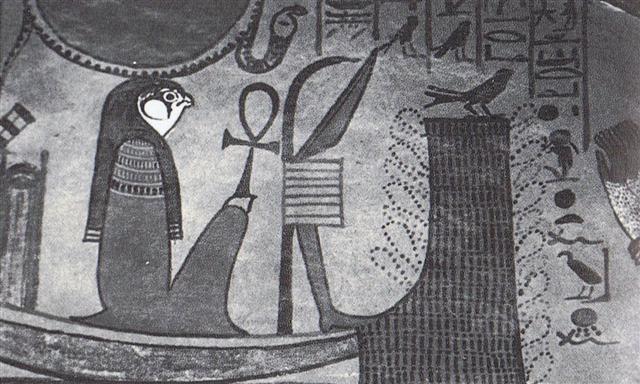The
last 4 glyphs in
line Ga7 clearly
could belong at the
beginning of line
Ga8. There are 13
feathers around
rakau at left in
Ga7-32 and at left
in Ga7-33 there is a
single great head
hanging down from
the top curve
(crook). This
'companion-of-the-king'
is close to the
night of 'death' (Mutu),
koke-na-make,
and
he has also an
outstretched leg as
Schemset in
front of Horus in
the Underworld:

| 26 Kane (Tane) |
27 Lono (Rogo) |
28 Mauli (Mauri) |
29 Muku (Mutu) |
 |
 |
 |
 |
| Ga7-31 (200) |
Ga7-32 |
Ga7-33 |
Ga7-34 |
| Lesath, δ Arae (264.7), Choo (264.9) |
Alwaid, Maasym (265.1), Shaula (265.3), Kuma (265.6), σ Arae (265.9) Hamal
|
Ras Alhague (266.1), Sargas (266.3), μ Ophiuchi, π Arae (266.5), Nan Hae (266.6), ι Herculis (266.7) |
λ Arae (267.1), Girtab, ο Serpentis (267.6) |
|
Ko Korķ
10 |
11 (345) |
12 |
13 |
|
ēDecember
6 (*260) |
7 |
8 |
9 |
|
'November
13 |
14 |
15 |
16 (*240) |
| 'Ko Ruti 13 |
14 |
15 |
16 (320) |
|
"October
30 |
31 |
"November 1 |
2 (*226) |
| ψ Orionis (81.1), Nihal (81.7) |
Mintaka, υ Orionis (82.4), χ Aurigae (82.5), ε Columbae (82.6) |
Al Hak'ah-3 / Mrigashīrsha-5 / Turtle-20 |
Three Stars-21 / ANA-IVA (7) |
| Arneb, Crab Nebula (83.0, φš Orionis (83.1), HEKA, Orion Nebula (83.2), φ˛ Orionis (83.6), Alnilam (83.7) |
Heavenly Gate, ν Columbae (84.0), ω Orionis (84.2), ALNITAK, PHAKT (Phaet) (84.7) |
|
He Maro
10 |
11 |
12 (163) |
13 |
|
ēJune
7 |
8 |
9 |
10 (*80) |
|
'May
14 |
15 |
16 (*56) |
17 |
|
'Vaitu
Potu 14 |
15 |
16 (136) |
17 |
|
"April
30 |
"May 1 |
2 (*42) |
3 |
Rei in Ga7-31
(200) - where we
possibly should
count 7 * 31 = 217 =
216 + 1 - coincided
with day 260 counted
from
ēMarch
21, which could
refer to the number
of days in a
tzolkin year. My
interpretation leads
to the midnight
culmination of Hamal
as the point in time
where next tzolkin
could begin - a
natural place for
Rogo (Lono).
It
should be noted that
the Rei
glyphs do not occur
on side b of the G
tablet:
... Rei in Ga7-31 (where 73 * 1 = 365 / 5 can be added to 73 * 4 at Ga7-34) is the 7th of 12 such glyphs. They fit nicely in the Gregorian structure:
| glyph positions |
+ 63 |
+ 80 |
| 1 |
 |
Ga1-30 (31) |
*94 |
'June 23 (St John's Eve)
(174) |
| 2 |
 |
Ga2-27 (58) |
*121 |
'July 20
(201) |
| 3 |
 |
Ga4-17 (101) |
*164 |
'September 1
(244) |
| 4 |
 |
Ga5-1 (112) |
*175 |
'September12
(255 = 355 - 100) |
| 5 |
 |
Ga5-6 (117) |
*180 |
'September 17
(260 = 255 + 5) |
| 6 |
 |
Ga7-22 (192) |
*255 |
'December 1
(335 = 255 + 80) |
| 7 |
 |
Ga7-31 (201) |
*264 |
'December 10
(344 = 244 + 100) |
December 13 (347) is 173 days after June 23 (St John's Eve). This means Rei number 8 (the perfect number) has position 174 + 174 = 348 (see below). 348 = 12 * 29.
All the last 5 Rei glyphs are in line a8, beyond 'December 13 and close to the solstice ...
|
Rei in the
position
corresponding to the
Hawaiian night of
Kane has an
upright top crescent
which may have been
meant to indicate
the god of trees (Tane).
It
should also be noted
that the maitaki
kind of glyph in
line Ga8 comes
in 2 variants, one
where - as in Ga8-21
- there is an
eye-catching bulge
at left in the
bottom oval, and
another - as in
Ga8-6 (11 days
earlier) where there
is no such sign.
Possibly the bottom
hemisphere at left
in the Egyptian
solstice picture is
also wider than the
rest of the 'buns':


 |
 |
 |
|
Ga8-10 |
Ga8-11 |
Ga8-12 (215) |
|
Purva Ashadha-20 |
Kaus Borealis (279.3) |
|
KAUS MEDIUS,
κ Lyrae (277.5), Tung Hae (277.7) |
KAUS AUSTRALIS
(278.3), ξ Pavonis (278.4), Al Athfar (278.6) |
|
Ko Korķ 23 |
24 |
25
(359) |
|
ēDecember
19 |
20 (354) |
21 (solstice) |
 |
 |
 |
 |
|
Ga8-13 |
Ga8-14 |
Ga8-15 (218) |
Ga8-16 |
|
ν Pavonis (280.4), κ
Cor. Austr. (280.9) |
Abhijit-22 |
no star listed (282) |
ζ Pavonis (283.4), λ
Cor. Austr. (283.6),
Double Double
(283.7), ζ Lyrae
(283.8) |
|
θ Cor. Austr. (281.0),
VEGA
(281.8) |
|
Ko Korķ 26 |
27 (361) |
28 |
29 |
|
ēDecember
22 |
23 |
24 |
25
(359) |
 |
 |
|
 |
 |
 |
|
Ga8-17 |
Ga8-18 |
Ga8-19
(222) |
Ga8-20 |
Ga8-21 |
|
South Dipper-8 |
Sheliak, ν Lyrae
(285.1), λ Pavonis (285.7) Atlas
|
Ain
Al Rami (286.2), δ
Lyrae (286.3), κ Pavonis (286.5), Alya (286.6) |
ξ Sagittarii (287.1), ω
Pavonis (287.3), ε Aquilae, ε Cor. Austr., Sulaphat (287.4), λ Lyrae
(287.7), Ascella,
Bered (Ant.) (287.9) |
Uttara Ashadha-21 |
|
Φ SAGITTARII
(284.0), μ Cor. Austr. (284.6), η Cor. Austr., θ Pavonis (284.8) |
NUNKI
(288.4), ζ Cor. Austr. (288.5), Manubrium (288.8), ζ Aquilae (288.9) |
|
Ko Korķ 30 (364) |
31 |
Tua Haro 1 |
2 |
3
(368) |
|
ēDecember
26 (360) |
27 |
28 |
29 |
30
(364) |
|




















